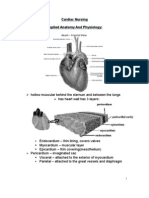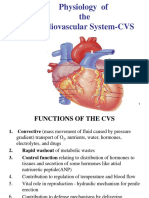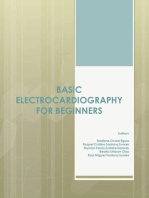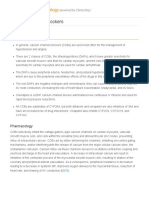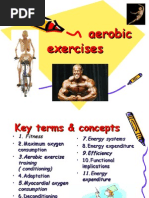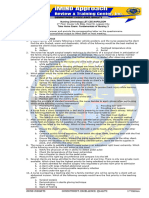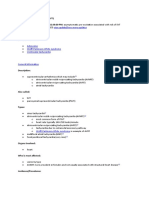Chapter20_NotesSpr21
Uploaded by
sirley1414Chapter20_NotesSpr21
Uploaded by
sirley1414Chapter 20 – The Heart
Notes
I. Four-chambered Organ [ONLINE]
The human heart is essentially two separate pumps (right heart/left heart) enclosed in a membrane called the pericardium.
The pericardium surrounds the heart and secretes a fluid that reduces friction as the heart beats. Fibrous tissues in the
pericardium protect the heart and anchor it to surrounding structures (diaphragm & sternum).
Heart wall composed of three layers:
• Epicardium, or visceral pericardium, is part of pericardium.
• Myocardium consists of thick bundles of cardiac muscle (layer that actually contracts).
• Endocardium is a thin sheet of endothelium that lines the heart chambers and helps blood flow smoothly through the
heart. It is continuous with the linings of the blood vessels leaving and entering the heart.
The upper chambers, right and left atria (atrium), receive blood returning to the heart. They are not important in the
pumping activity of the heart. Blood flows into the atria under low pressure from the veins and then continues to fill the
ventricles.
The lower chambers, right and left ventricles, pump blood out of the heart. The right ventricle pumps blood to the lungs
(pulmonary circulation). The left ventricle is the thickest chamber of the heart because it has to do most of the work to pump
blood to all parts of the body (systemic circulation).
Vertically dividing the right and left sides of the heart is a common wall called the septum. The septum prevents the mixing of
oxygen-poor and oxygen-rich blood.
Draw a heart. Know the pulmonary pump, systemic pump, and the order of all structures through which blood flowing
through the heart would pass (Figure 20-1).
BIOL 2402_AMC8 Anatomy and Physiology II 1
II. Conducting System
The heart contracts on its own. This is called _______________ (autorhythmic), meaning it can contract without any
stimulation from ___________. The heart contains specialized cells in nodes that contain excessive numbers of leaky sodium
channels that allow them to slowly drift towards threshold and fire _______________ without _____________________.
Cardiac muscle cells, cardiocytes, are connected by __________________ or _________________. These gap junctions
connect cardiac muscle fibers mechanically and electrically allowing an ______________ to spread in ___________. When the
first group is stimulated, they in turn stimulate neighboring cells. Those cells stimulate more cells. This chain reaction
continues until all cells contract. The wave of activity spreads in such a way that the ________and the _________________
contract in a steady rhythm.
____________ and __________________ can alter the basic cardiac rhythm (pace) of the heart by increasing or decreasing it,
but do not make the _____________________. If all nerves to the heart are cut, it will continue to beat.
Sinoatrial (SA) Node: The SA-node is the natural ______________of the heart. It is located in the posterior area of the right
atrial wall, inferior to the opening of the superior vena cava. It initiates each heartbeat, without stimulation from the
_____________________, and sets the pace for the ______________. It generates an action potential ________ than other
nodal tissues. The action potential spreads throughout the two atria causing them to contract from _____________. This
wave of contraction travels from the ________ toward the _________. This forces blood through the two AV valves in the
floor of the atria into the ventricles to fill them. It also sends the action potential through the internodal pathway.
Internodal pathways: Fibers in the atrial wall which connect the _________ to the __________ for stimulus conduction.
Atrioventricular (AV) Node: The AV-node is located in the _____________ between the right and left ventricles near the
opening of the coronary sinus. The AV-node depolarizes more ____________than the SA node and relays the electrical
impulse to the muscle cells that make up the _______________. The ventricles contract almost simultaneously a fraction of a
second after the atria, completing one full heartbeat. These contractions cause the chambers to squeeze the blood, pushing it
in the proper direction along its path.
Atrioventricular (AV) Bundle (Bundle of His): Located in the _________________ and carries the action potential from the
__________ to ___________. Bundle branches carry the action potential down to the apex of the heart in each ventricle and
then spread out into __________________.
Purkinje Fibers: Tiny divisions that carry action potentials to the cells of the ________________. These fibers fan out into
each ventricle at the apex of the heart and start an action potential spreading from the ____________ of the heart throughout
each _____________________. This causes the ventricles to contract in a wave from the _______________ (apex towards
base), forcing blood up through the _________________ and into the ____________ and ______________ arteries.
Basic Sequence of Events of Conduction System:
1. SA node automatically depolarizes and spread an action potential through the atria
2. Atria contract from the top down while the action potential spread through the intermodal pathway
3. Action potential reaches the AV node
4. AV node spreads the action potential to Bundle of His and bundle branches
5. Purkinje fibers spread action potential through ventricles
6. Ventricles contract from the apex upward, blood is pumped to pulmonary and aortic arteries
BIOL 2402_AMC8 Anatomy and Physiology II 2
Define:
Cardiac Skeleton-
Electrocardiogram (ECG or EKG)
An electrocardiogram is a recording of the electrical events of the cardiac cycle. __________________ of the heart can be
detected by sensors placed on the body surface and then amplified by a machine and read. ECGs are useful in detecting and
diagnosing _____________________ (abnormal heart patterns). A ________________ is a normal heart rhythm.
The ECG is read as a series of electrical waves spreading through the heart. Each wave on the ECG corresponds to a physical
event like the contraction or relaxation of the atria or ventricles. Each ECG wave occurs within a specific range of time during
the cardiac cycle. If the wave is too long, too short, or the pauses between the waves vary, then there are physical problems
with the heart that can be visualized on an ECG.
Define:
Bradycardia –
Tachycardia –
What physical events correspond to the following electrical events? (Be able to identify them)
P wave
QRS Complex
T Wave
Why is repolarization of the atria not visible on an ECG?
Contractile Cells
For cardiocytes to contract they must conduct an action potential across their cell membranes. Cardiocytes are different from
skeletal muscle cells because they __________ require ____________ stimulation. Cardiocytes are not electrically isolated
but have specialized connections, intercalated discs, that allow an action potential (ions) to flow directly from one cardiocyte
to the next. This allows cardiac action potentials to spread throughout the heart muscle like a wave.
BIOL 2402_AMC8 Anatomy and Physiology II 3
Action Potential in Cardiac Muscle:
The resting potential in a ventricular cell is ______ (-70 in neurons and -85 in skeletal muscle) and the threshold is about
_______. Since nodal cells have excessive numbers of leaky sodium channels, the SA node will depolarize automatically the
threshold and start an action potential that eventually spread through all cardiocytes of the heart. Cardiocyte action
potentials are very prolonged and last approximately ___________________ (action potentials in neurons and myofibers are
2 – 3 msec).
Steps of an Action Potential in Cardiac Muscle:
_______________________: ______________ electrically stimulate voltage-regulated sodium channels to open and
extracellular sodium flows into contractile cells and causes rapid depolarization of the fiber’s sarcolemma to +30 mV. The
voltage sodium channels are called _________channels.
______________________: At +30 mV, the _______ sodium channels ________, ___________ channels _______, but do so
very ____________, allowing potassium to slowly leak out. At the same time, slow voltage-regulated calcium channels open.
Extracellular ____________enters the heart cell and maintains the transmembrane potental above 0mV. This plateau
_____________ the action potential in the heart cell. Extracellular calcium triggers intracellular calcium to be released from
the SR. The voltage-regulated sodium channels stay closed until -60mV.
___________________: When the slow voltage-regulated calcium channels begin to _________, slow voltage-regulated
potassium channels ________ and the membrane ____________ and slowly returns to the ____________________.
Draw and label a graph of a heart action potential (Figure 20-15)
At times, muscle tissue has a loss of excitability and cannot respond to additional ______________. This
_____________period differs between skeletal and cardiac muscle. Skeletal muscle fibers can be stimulated to contract again
before they relax. Contractions are summed to produce a prolonged tetanic contraction. Cardiac muscle fibers cannot be
stimulated to contract again until they have ______________. This prevents tetanic contractions.
What would happen if the heart had the same refractory period as skeletal muscle?
BIOL 2402_AMC8 Anatomy and Physiology II 4
Read – HEART DISEASE AND HEART ATTACKS (Figure 20-9) – Know the general information about enzymes and risk factors.
Answer the following:
How are enzymes used to determine the occurrence of a heart attack?
What are the risk factors that increase the chances of a heart attack?
III. Events during the Cardiac Cycle
_________________ – One complete heartbeat which includes the ____________ and ____________ periods of the ______
and the _______________. The atria __________ while the ventricles _________, the ventricles _________ while the atria
_________, then all chambers relax.
Define:
Systole –
Diastole –
It is important to remember that blood will only fill a chamber while it is ________and ___________ in that chamber is
________than the preceding area. During atrial diastole, there is very little ___________ in the atria. As blood enters the
atria the ___________ are open as long as the __________ are also in __________, allowing approximately _____ of
ventricular filing to occur during ______ diastole. The atria do not have to contract to get blood into the ventricles. Atrial
systole “tops off” the ventricles, filling that last 30% to get maximum blood flow.
Events of the Cardiac Cycle
The atria are constantly receiving blood from veins. Ventricles receive blood while relaxed.
1. All chambers relaxed, blood flows into atria --- through open AV valve --- into ventricle.
2. Atrial systole occurs to complete filling of ventricles.
3. Ventricular systole occurs and pressure closes AV valve and soon opens the semilunar valves.
4. Blood is pumped into the pulmonary and aortic trunks.
5. Ventricles relax and all chambers are now in diastole.
6. As blood pressure drops, the semilunar valves in trunks close to prevent backflow of blood into ventricles, the AV
valves open. Atria fill with blood and cardiac cycle repeats.
Complete the following table (refer to Figure 20-12 & 20-16)
Ventricular Activity Basic Action of Atrioventricular Valves Basic Action of Semilunar Valves
Ventricular Diastole
Ventricular Systole
BIOL 2402_AMC8 Anatomy and Physiology II 5
Use Figure 20-17 to answer the following:
What is the relationship between left ventricular pressure and left ventricular volume? What is isovolumetric contraction?
When is blood ejected from the left ventricle?
What is the dicrotic notch and why does it occur?
Heart Sounds
__________________is the process of listening to the sounds of the heart using a stethoscope. The sounds are created by
________________ of the ________ and ________ valves. First two sounds are easy to hear and described as “lubb-dupp.”
The first heart sound (S1), the “lubb,“ is produced by the closure of the ___________valves during
__________________________.
The second heart sound (S2), the “dupp,” is produced by the closure of the __________valves during
___________________________.
The third sound (S3) is blood flowing into the ventricles (very faint and seldom audible in healthy adults).
The fourth sound (S4) is the sound of the atria contracting (very faint and seldom audible in healthy adults).
________________ or backflow of blood into an atrium is due to a dysfunction of an ______________valve. Improper closure
of the _______________________, called mitral valve prolapsed, causes regurgitation. Heart murmurs are sounds created by
regurgitation and unusual chamber circulation of blood.
IV. Cardiodynamics
Although the heart is ____________ and can beat ___________any hormonal or neural stimulation, the rate of the heartbeat
must be sped up or slowed down to meet the oxygen demands of the body’s tissues. _______________ is the study of the
mechanisms and abilities of the heart to alter the _______of blood being pumped to tissues to meet these changing demands.
Define:
Cardiac Output (CO) –
Heart Rate (HR) –
Stroke Volume (SV) –
BIOL 2402_AMC8 Anatomy and Physiology II 6
Write the equation showing the relation between CO, HR, and SV
CO =
Problem 1: Calculate the cardiac output for a normal, average person assuming the average HR = 75 bpm and average SV =
80 mL
CO =
CO =
Cardiac output is highly _______________. The heart rate can increase to 2.5x average or up to 180 to 200 bpm. Stroke
volume can almost double up to about 130 mL per contraction. During strenuous exercise cardiac output can increase
between 300-500% up to about 30L per minute. In well-conditioned athletes, CO can increase up to around 700% or 40L/min.
______________ is the maximum CO – resting CO around 24 L for a normal individual.
Factors Affecting the Heart Rate - [Read entire section]
The normal heart rate (HR) is called the _______ heart rate which is set by the __________ and a bit of parasympathetic
slowing to an average of 75 bpm. There are a number of major factors that can affect heart rate such as modification by the
autonomic nervous system, hormones, ion concentration, and body temperature. If the body’s oxygen demands increase due
to increased stress or activity, the heart must increase its ________. If oxygen demands decrease, heart rate can _________.
Autonomic Innervation [Figure 20-21]
The heart is innervated by nerves of the ________. ________________ fibers are more numerous than _____________fibers
and have a greater affect on the heart. Both sympathetic and parasympathetic nerves are located at the ____ and _____
nodes and can regulate the conduction system of the heart.
____________________ = “fight or flight” responses (excitement, exercise, stress, and survival situations). The
neurotransmitter norepinephrine (NE) = increases the heart rate and force of contraction.
_____________________ = “rest and digest” response, a return to normal homeostasis. Neurotransmitter acetylcholine (ACh)
= decreases heart rate and force of contraction. Innervation is from the Vagus nerve which synapses directly on the SA and AV
nodes.
Effects of the SA Node = Autonomic nerves change the permeability of the SA Node.
How does sympathetic stimulation increase the heart rate?
The medulla of the brain contains the control centers for cardiac function. Complete the following table
Name of Center ANS Nerves Neurotransmitter Affect on HR
Cardio acceleratory
Cardio inhibitory
BIOL 2402_AMC8 Anatomy and Physiology II 7
Atrial Reflex
The brain must receive sensory info from the heart to make the appropriate adjustments to meet the body’s oxygen demands.
There are ____________ receptors (baroreceptors) and ____________ receptors in the walls of the __________, the
_____________, and the ___________. The atrial reflex adjusts the heart rate in response to __________ in venous return in
order to pump the excess blood returning to the heart. EX. Person exercising – skeletal muscles massage or help pump blood
from the veins back to the heart increasing venous return. The excess blood filing the atria will stretch the walls stimulating
these stretch receptors. The receptors send axons to the cardio acceleratory center of the brain to increase sympathetic
stimulation to the heart. This increases heart rate to move the blood faster.
Hormones – Certain hormones influence heart rate. Epinephrine, norepinephrine, and thyroid hormone ___________ HR by
stimulating the ___________ or myocardium. ______________________ (ANP) is a hormone released by cardiocytes of the
atrial walls when ___________________ due to increased blood pressure during resting periods. The cardiocytes of the atria
release ANP which targets the _________ and increases Na+, Cl-, and water loss (water follows salt by osmosis) at the kidneys.
Urinating the excess fluid will ____________ blood volume and blood pressure (letting water out of a water balloon). ANP
also _________ the release of ADH, NE, E, and Aldosterone, all of which can _________ blood pressure.
Problem 2: Calculate the CO with an increase in HR
Assume HR is now 100 bpm due to mild exertion and SV = 80 mL
CO =
CO =
Factors Affecting Stroke Volume
Not all of the blood in a ventricle is pumped out with each stroke. If 100% of the blood volume of a ventricle were pumped
with each stroke there would be no way to increase CO to meet increased oxygen demands during stress or exercise. To
calculate SV we must know how much blood is in the ventricle before contraction and subtract the amount left in the ventricle
after contraction.
Define:
End-Diastolic Volume (EDV) –
End-Systolic Volume (ESV)-
Write the equation used to calculate Stroke Volume:
SV =
Problem 3 : Calculate Average Stroke Volume if EDV = 130 mL and ESV is 50 mL
SV =
SV =
BIOL 2402_AMC8 Anatomy and Physiology II 8
End-Diastolic Volume
EDV is approximately 120 mL in the average healthy adult. About _____ of blood flows into the ventricle due to _______ and
the remaining 30% is done by atrial contraction.
EDV is determined by 2 factors:
_____________________ – the length of ventricular diastole. Blood can only flow into a ventricle while it is relaxed. Heart
rate determines the filling time.
______________________ – the rate at which blood is returning to the heart and the filling of the ventricles and atria.
Contraction of skeletal muscles squeezes on veins and increases the flow of blood into the heart.
As HR _____________, filling time ___________________. The less time to fill a ventricle, the ____________ the EDV will be.
This could reduce CO by decreasing SV. During exercise, although filling time has decreased, CO is increased because stroke
volume increases to compensate for the shorter filling time. If HR increases about 170, SV can’t compensate for extremely
short filling time and CO begins to decline.
If venous return increases what would happen to EDV?
End-Systolic Volume
Regulated by three physiological mechanisms: Preload, Contractility, Afterload
_______________ – Increased ventricular stretching due to increased venous return. If venous return ___________, the
myocardium is stretched out due to the __________ and __________ of the increased blood return. The stretching of the
heart muscle stretches the sarcomeres which can result in more forceful contractions which will pump __________ blood out
of the heart. This is called the Frank-Starling Principle – “increased EDV results in increased stroke volume and decreased
ESV” or the more blood entering the ventricle = the more blood pumped out.
_________________ – Increased __________ of contraction. Sympathetic stimulation will increase contractility, increasing SV
and decreasing ESV, also increasing CO. Parasympathetic stimulation will decrease contractility, decreasing SV and increasing
ESV, which decreases CO.
_________________ – Force necessary to ________ the _____________ valves to eject blood from the ventricles. Blood in
the aortic and pulmonary trunks is ____________ against the SL valves. When the ventricles contract, they must do so with
enough _________ to open the valves. Anything that increases the backward pressure of blood against the SL valves (blocked
arteries or high BP) increases the afterload and forces the heart to contract harder to pump blood. This will increase ESV, and
decrease SV an CO.
Complete the following table:
Autonomic Effect on Heart Rate and Force of Effect on ESV Effect on SV
Stimulation Contraction
Sympathetic HR and force of contraction increase
Parasympathetic HR and force of contraction decrease
What would happen to ESV if the afterload on the heart increased?
BIOL 2402_AMC8 Anatomy and Physiology II 9
Problem 4: Calculate CO during moderate exercise that results in EDV = 180 mL, ESV=20 mL, and HR = 150 bpm
SV =
SV =
CO =
CO=
A patient’s BP is 150/110. Explain the change in afterload and its effect on ESV, SV, and CO.
Define:
Cardiac arrest –
Cardiomegaly –
Congestive heart failure –
Heart block-
Myocarditis –
BIOL 2402_AMC8 Anatomy and Physiology II 10
You might also like
- Physiology of The Cardiovascular System-CVS67% (3)Physiology of The Cardiovascular System-CVS56 pages
- The 12-Lead Electrocardiogram for Nurses and Allied ProfessionalsFrom EverandThe 12-Lead Electrocardiogram for Nurses and Allied ProfessionalsNo ratings yet
- JAMAL MACABANGUN FINAL - Medical-Surgical-Nursing-Exam-group-2No ratings yetJAMAL MACABANGUN FINAL - Medical-Surgical-Nursing-Exam-group-213 pages
- The Cardiovascular System. Cardiac MuscleNo ratings yetThe Cardiovascular System. Cardiac Muscle67 pages
- Physiology of The Cardiovascular System The HeartNo ratings yetPhysiology of The Cardiovascular System The Heart15 pages
- Topic_2_CIRCULATORY_SYSTEM_PART_IV_HEART_PHYSIOLOGY_for_studentsNo ratings yetTopic_2_CIRCULATORY_SYSTEM_PART_IV_HEART_PHYSIOLOGY_for_students35 pages
- Cardiovascular System: The Heart: Student Learning OutcomesNo ratings yetCardiovascular System: The Heart: Student Learning Outcomes10 pages
- Functional Human Physiology: For The Exercise and Sport Sciences The Cardiovascular System: Cardiac FunctionNo ratings yetFunctional Human Physiology: For The Exercise and Sport Sciences The Cardiovascular System: Cardiac Function186 pages
- Lecture 2: The Heart: Prof. Magidah Alaudi, M.SCNo ratings yetLecture 2: The Heart: Prof. Magidah Alaudi, M.SC62 pages
- The Cardiovascular System - PresentationNo ratings yetThe Cardiovascular System - Presentation42 pages
- Lecture Outline: Cardiovascular PhysiologyNo ratings yetLecture Outline: Cardiovascular Physiology146 pages
- AY18 CVS Physio 1_Electrical Basis and ECG v2No ratings yetAY18 CVS Physio 1_Electrical Basis and ECG v238 pages
- Introduction & Conducting Tissue of HeartNo ratings yetIntroduction & Conducting Tissue of Heart38 pages
- Physiology of The Cardiovascular System-CVSNo ratings yetPhysiology of The Cardiovascular System-CVS56 pages
- Physiology of The Cardiovascular System-CVSNo ratings yetPhysiology of The Cardiovascular System-CVS56 pages
- EKG | ECG: An Ultimate Step-By-Step Guide to 12-Lead EKG | ECG Interpretation, Rhythms & Arrhythmias Including Basic Cardiac DysrhythmiasFrom EverandEKG | ECG: An Ultimate Step-By-Step Guide to 12-Lead EKG | ECG Interpretation, Rhythms & Arrhythmias Including Basic Cardiac Dysrhythmias3/5 (5)
- Heart Muscle Diseases, A Simple Guide To The Condition, Diagnosis, Treatment And Related ConditionsFrom EverandHeart Muscle Diseases, A Simple Guide To The Condition, Diagnosis, Treatment And Related ConditionsNo ratings yet
- Heart, Functions, Diseases, A Simple Guide To The Condition, Diagnosis, Treatment And Related ConditionsFrom EverandHeart, Functions, Diseases, A Simple Guide To The Condition, Diagnosis, Treatment And Related ConditionsNo ratings yet
- EKG/ECG Interpretation Made Easy: A Practical Approach to Passing the ECG/EKG Portion of NCLEXFrom EverandEKG/ECG Interpretation Made Easy: A Practical Approach to Passing the ECG/EKG Portion of NCLEX5/5 (2)
- Weaning From Mechanical Ventilation: Moderator - Dr. Arvind Khare Presented by - Dr. Aji Kumar JLN Medical College, AjmerNo ratings yetWeaning From Mechanical Ventilation: Moderator - Dr. Arvind Khare Presented by - Dr. Aji Kumar JLN Medical College, Ajmer28 pages
- Recomendaciones Del VI Consenso Clinico de SIBEN PNo ratings yetRecomendaciones Del VI Consenso Clinico de SIBEN P21 pages
- Drug Class Overviews Calcium Channel Blockers Clinical PharmacologyNo ratings yetDrug Class Overviews Calcium Channel Blockers Clinical Pharmacology11 pages
- 2019 (Impellizzeri) Internal and External Load-15 Years OnNo ratings yet2019 (Impellizzeri) Internal and External Load-15 Years On5 pages
- Drowning - Forensic Pathology Online PDFNo ratings yetDrowning - Forensic Pathology Online PDF14 pages
- Electrogastrography Basic Knowledge, Recording, Processing andNo ratings yetElectrogastrography Basic Knowledge, Recording, Processing and15 pages
- Allen Et Al. (2008) .Muscle Fatigue. Cellular MechanismsNo ratings yetAllen Et Al. (2008) .Muscle Fatigue. Cellular Mechanisms47 pages
- La Ode Muhammad Zuhdi Mulkiyan F1C116075 Faculty of Math and Science Haluoleo UniversityNo ratings yetLa Ode Muhammad Zuhdi Mulkiyan F1C116075 Faculty of Math and Science Haluoleo University20 pages
- The 12-Lead Electrocardiogram for Nurses and Allied ProfessionalsFrom EverandThe 12-Lead Electrocardiogram for Nurses and Allied Professionals
- JAMAL MACABANGUN FINAL - Medical-Surgical-Nursing-Exam-group-2JAMAL MACABANGUN FINAL - Medical-Surgical-Nursing-Exam-group-2
- Topic_2_CIRCULATORY_SYSTEM_PART_IV_HEART_PHYSIOLOGY_for_studentsTopic_2_CIRCULATORY_SYSTEM_PART_IV_HEART_PHYSIOLOGY_for_students
- Cardiovascular System: The Heart: Student Learning OutcomesCardiovascular System: The Heart: Student Learning Outcomes
- Functional Human Physiology: For The Exercise and Sport Sciences The Cardiovascular System: Cardiac FunctionFunctional Human Physiology: For The Exercise and Sport Sciences The Cardiovascular System: Cardiac Function
- EKG | ECG: An Ultimate Step-By-Step Guide to 12-Lead EKG | ECG Interpretation, Rhythms & Arrhythmias Including Basic Cardiac DysrhythmiasFrom EverandEKG | ECG: An Ultimate Step-By-Step Guide to 12-Lead EKG | ECG Interpretation, Rhythms & Arrhythmias Including Basic Cardiac Dysrhythmias
- Heart Muscle Diseases, A Simple Guide To The Condition, Diagnosis, Treatment And Related ConditionsFrom EverandHeart Muscle Diseases, A Simple Guide To The Condition, Diagnosis, Treatment And Related Conditions
- Heart, Functions, Diseases, A Simple Guide To The Condition, Diagnosis, Treatment And Related ConditionsFrom EverandHeart, Functions, Diseases, A Simple Guide To The Condition, Diagnosis, Treatment And Related Conditions
- EKG/ECG Interpretation Made Easy: A Practical Approach to Passing the ECG/EKG Portion of NCLEXFrom EverandEKG/ECG Interpretation Made Easy: A Practical Approach to Passing the ECG/EKG Portion of NCLEX
- Weaning From Mechanical Ventilation: Moderator - Dr. Arvind Khare Presented by - Dr. Aji Kumar JLN Medical College, AjmerWeaning From Mechanical Ventilation: Moderator - Dr. Arvind Khare Presented by - Dr. Aji Kumar JLN Medical College, Ajmer
- Recomendaciones Del VI Consenso Clinico de SIBEN PRecomendaciones Del VI Consenso Clinico de SIBEN P
- Drug Class Overviews Calcium Channel Blockers Clinical PharmacologyDrug Class Overviews Calcium Channel Blockers Clinical Pharmacology
- 2019 (Impellizzeri) Internal and External Load-15 Years On2019 (Impellizzeri) Internal and External Load-15 Years On
- Electrogastrography Basic Knowledge, Recording, Processing andElectrogastrography Basic Knowledge, Recording, Processing and
- Allen Et Al. (2008) .Muscle Fatigue. Cellular MechanismsAllen Et Al. (2008) .Muscle Fatigue. Cellular Mechanisms
- La Ode Muhammad Zuhdi Mulkiyan F1C116075 Faculty of Math and Science Haluoleo UniversityLa Ode Muhammad Zuhdi Mulkiyan F1C116075 Faculty of Math and Science Haluoleo University



























